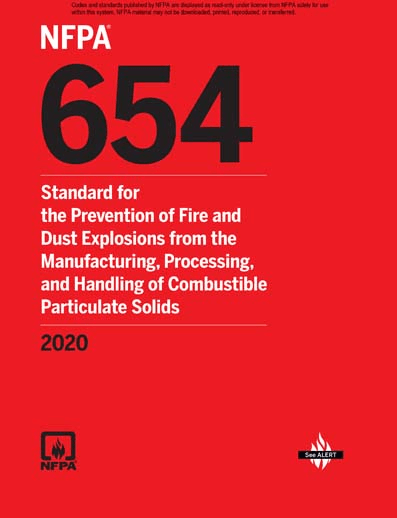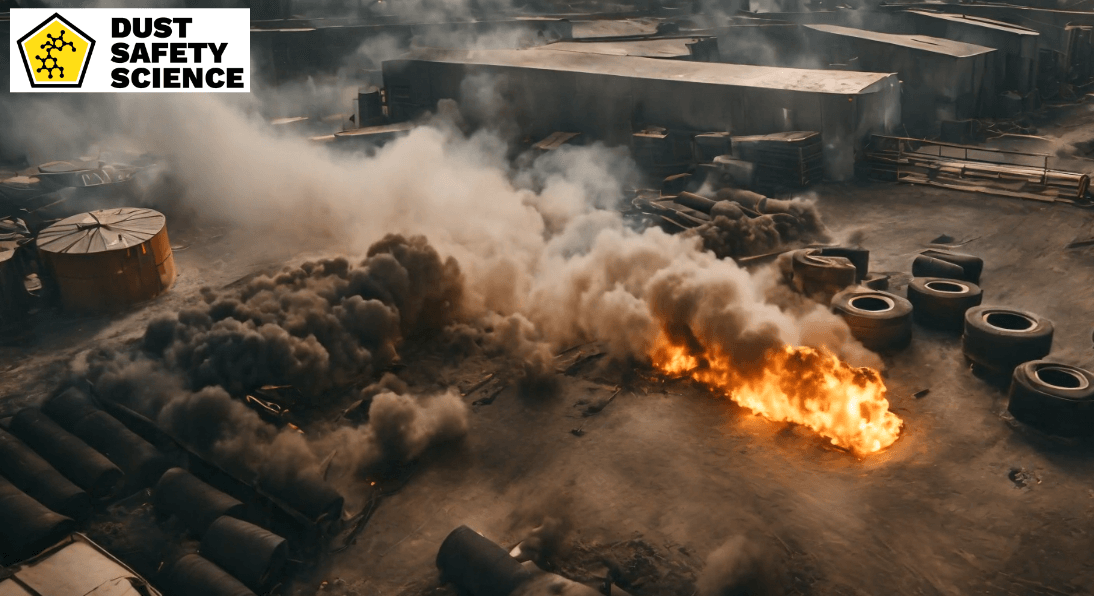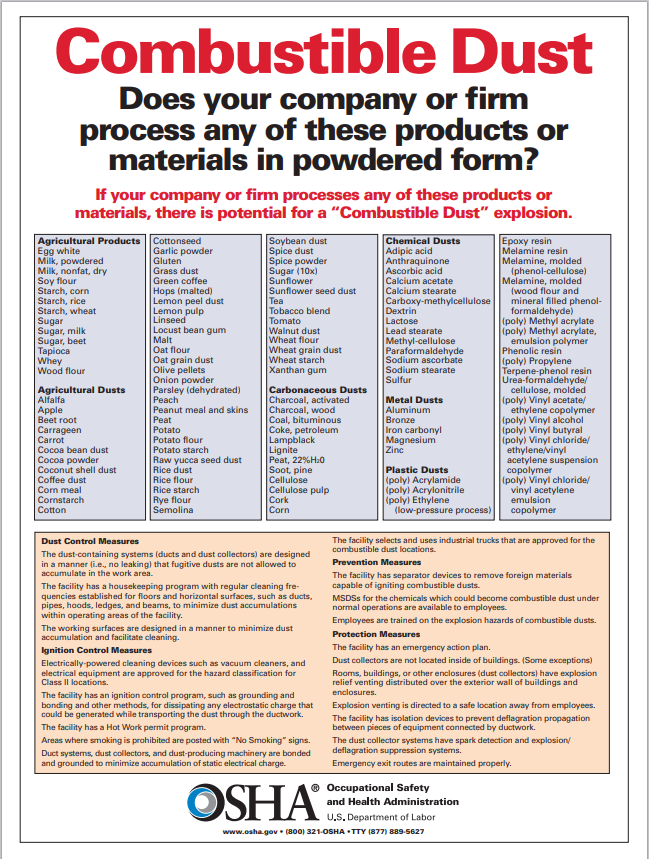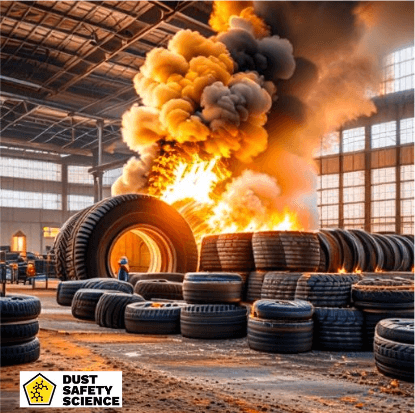Updated September 23, 2024 Authored by Dr. Chris Cloney and Jon Barrett of Dust Safety Science
A picture of a Combustible Dust Fire and Hazard, inside a Rubber Manufacturing Facility
Key Takeaways:
- Industry Dynamics: The rubber industry plays a critical role in manufacturing, providing essential products across a wide range of sectors including automotive, construction, and consumer goods. The rubber industry operations involve the chemical processing of rubber compounds, additives, and fillers through various equipment and manufacturing processes, that create dust, creating environments where combustible dust hazards can arise.
- Hazards of Combustible Dusts: Combustible dust poses a significant threat within the rubber industry, generated during mixing, milling, spraying, and other processing stages. Fine particles of rubber compounds and additives can accumulate in workspaces and ventilation systems when in the right concentration, increasing the risk of ignition, such as static electricity, and dust explosions when suspended in air. The combustibility of rubber powders, combined with the dispersal of dust through machinery and processes, underscores the importance of robust safety measures to prevent accidents, and a primary explosion.
- Specific Concerns: Specific concerns within the rubber industry include the inherent combustibility of rubber materials, as well as the machinery and processes involved in production. Equipment such as mixers, extruders, and curing machines can generate rubber dust and plastic dust particles, and dust in small particle sizes, through friction and mechanical processes, heightening the risk of explosions. Chemical processes like compounding, molding, and vulcanization introduce additional sources of combustible dusts, necessitating diligent maintenance, dust control measures, and employee training to mitigate hazards effectively.
Combustible Dust Hazards, in the Rubber Industry:
Dust Hazards in the Rubber Industry require a comprehensive grasp of the underlying factors contributing to the risk of an explosion. The Occupational Safety and Health Administration, (OSHA), identifies Rubber as a Combustible Dust. Fine particles generated during various stages of rubber processing, such as mixing, milling, and spraying, constitute the primary source of combustible dusts in these facilities. These rubber product particles, in small particle size, possess inherent combustibility, characterized by their ability to ignite and propagate flames rapidly under certain conditions, and the right concentration, and a possibility from another oxidizing medium. Additionally, the dispersal of dust through equipment, or in a confined space such as dust collection systems, and HVAC systems amplifies the risk, increasing dust clouds suspended in the air, and creating environments conducive to ignition, a fire hazard, and a primary explosion hazard.
The dynamics of dust hazards in the rubber industry hinge on several critical factors and classifications. Firstly, the materials used in rubber production, including rubber compounds, additives, and fillers, play a pivotal role in determining the combustibility of the rubber dust generated and dust accumulation. Certain formulations may exhibit heightened reactivity, necessitating meticulous control and monitoring to mitigate the risk effectively. Furthermore, the equipment utilized in rubber processing, such as grinders, pulverizers, and conveyor systems, contribute to the small particle size of dust, including the dispersion and accumulation of rubber dust. Vibrations, friction, and mechanical processes within this machinery can generate a fine particle size, that settles in workspaces and HVAC systems, or create dust clouds and dust suspended in air, or some other oxidizing medium, over a range of concentrations, increasing the likelihood of a deflagration hazard and dust explosion.
Mitigating dust hazards in the rubber industry requires a multifaceted approach encompassing a Dust Hazard Analysis, (DHA), proactive risk assessment, robust capturing, containing and cleaning protocols, and employee training. Employing effective dust control measures, such as proper ventilation, dust collection systems, and housekeeping practices, is crucial for minimizing a deflagration hazard, from the accumulation and dispersion of combustible dusts suspended in the air and causing a dust explosion. Additionally, implementing engineering controls and protection systems can help mitigate the consequences of a dust explosion should they occur. A manufacturing facility may have a gas stove or another ignition source in the processing facility, and cause dust to catch fire. Employee education and training programs focused on hazard awareness, safe work practices, and emergency response procedures further bolster the industry’s ability to mitigate dust hazards and uphold workplace safety standards, to prevent a dust explosion. When five conditions related to dust, dispersion, confinement, oxidant, and an ignition source exist, this is known as the dust explosion pentagon.

A picture of the NFPA Guide to Combustible Dusts and NFPA 654 Standard for Preventing Combustible Dust Explosions
The Rubber Industry-Specific Concerns with Combustible Dust
The rubber industry faces specific concerns regarding dust hazards that stem from the nature of its rubber products as combustible materials, dust generating equipment, and processes. One significant hazard concern is the combustibility of rubber dust compounds and additives used in manufacturing. These materials often generate fine dust during mixing, milling, and processing operations, which can accumulate and disperse throughout the facility. Given the combustible nature of rubber powders, even small accumulations of rubber dust pose a significant explosion hazard, in the right concentration, and pose a risk if ignited. The presence of dusts in plastics, chemicals, dyes, pharmaceuticals, fibers, rubber products, and many other production settings presents combustible material that can catch fire and possible combustible explosion hazards and result in injuries, deaths, and damage to and destruction of buildings.
The presence of dust in plastics, rubber, chemicals, dyes, pharmaceuticals, fibers, and many other production settings presents dust explosion hazards that can result in injuries, deaths, and damage to and destruction of buildings. The National Fire Protection Association, NFPA 654, Standard for the Prevention of Fire and Dust Explosions from the Manufacturing, Processing, and Handling of Combustible Particulate Solids, 2020 edition, is referenced by OSHA’s Combustible Dust National Emphasis Program (NEP) to identify explosion hazards and define mitigation strategies that help protect life and property.
Furthermore, the equipment used in the rubber industry presents unique challenges in managing combustible material and dust. Machinery such as mixers, extruders, and curing machines can generate dust through friction and mechanical processes, and under certain conditions, create environments conducive to dust explosions, such as creating a dust cloud. Ensuring proper maintenance of equipment and implementing effective dust control measures are crucial in mitigating these risks. Additionally, the layout and design of the facility, including ventilation systems and dust collection mechanisms, play a critical role, to minimize dust accumulation and managing dust hazards in the rubber products industry. Continuous inspection and maintenance planned safely, especially in confined spaces, are critical to identifying any potential dust incidents.
Specific manufacturing processes in the rubber industry, such as compounding, molding, and vulcanization, introduce additional sources of dust. These processes involve the handling and manipulation of materials in environments where dust particles can easily accumulate. Confined spaces in manufacturing industries are prevalent. As a result, meticulous attention to housekeeping practices, regular equipment inspections, and employee training on explosion hazard awareness are essential for minimizing the risk of dust explosions, and possibly a secondary dust explosion. By addressing these specific concerns and implementing comprehensive safety measures from the National Fire Protection Association, NFPA, the rubber industry can mitigate the threat of dust hazards and uphold workplace safety standards.

A picture of a Combustible Dust Fire and Hazard, at a Rubber Manufacturing Facility
Historic Rubber Industry Related Combustible Dust Explosions
Historic rubber industry-related combustible dust explosions serve as poignant reminders of the devastating consequences that can arise from inadequate safety measures and awareness. Throughout history, several notable incidents have underscored the dangers posed by dust in rubber manufacturing facilities. For instance, the 2003 explosion at the West Pharmaceutical Services plant in Kinston, North Carolina, resulted in six fatalities and numerous injuries, highlighting the need for stringent dust control measures in rubber and chemical manufacturing processing operations. Combustible dust incidents, continue to occur worldwide and in the rubber industry, as presented in this combustible dust research and incident database from Dust Safety Science. In addition, statistics of the most prevalent industries, regarding combustible dust incidents, are also captured in this Annual Incident Report Database, from Dust Safety Science. Some of the historic rubber dust explosions include:
- According to The U.S. Chemical Safety and Hazard Investigation Board, (CSB), on January 29, 2003, a combustible dust explosion at the West Pharmaceutical Services, Inc., plant in Kinston, North Carolina, killed six workers and injured 38 others, including two firefighters. The Kinston facility manufactured rubber drug-delivery components such as syringe plungers, septums, and vial seals. Production operations included rubber compounding, molding, and extrusion. The rubber compounding process consisted of two separate production lines, each with a mixer, a mill, and batch off equipment. Raw materials were prepared in another area of the plant. The U.S. Chemical Safety and Hazard Investigation Board, (CSB), determined that accumulated polyethylene dust above a suspended ceiling fueled the explosion. Because of the extent of damage to the Kinston facility, it was not possible to definitively determine the event that dispersed the dust or what ignited it. CSB determined the following root causes of the January 29 incident:
- West did not perform an adequate engineering assessment of the use of powdered zinc stearate and polyethylene as anti tack agents in the rubber batch off process.
- West engineering management systems did not ensure that relevant industrial fire safety standards were consulted.
- West management systems for reviewing material safety data sheets did not identify dust hazards.
- The Kinston plant’s hazard communication program did not identify dust hazards or make the workforce aware of such.
2. The Jasper Rubber Plant explosion, (2015) in Jasper, Indiana. Jasper firefighters battled super-heated flames while contending with freezing gear when a dust bin collection system at a Jasper Rubber plant caught fire.
3. On January 7, 2021, the Jonesborough City Press reported an explosion and fire at a rubber manufacturing plant in Jonesborough, Tennessee. The cause of the explosion was unknown but believed to have started during manufacturing. The fire was expected to burn for days. Officials warned nearby farmers to keep their livestock away from a nearby creek due to toxins from the runoff water.
4. On June 8, 2021, Plant Services reported an explosion at the Humane Manufacturing rubber flooring company in Janesville, Wisconsin. The incident was called in at 12:06 p.m. The initial call said a silo had exploded and was on fire. Upon arrival, fire crews observed that two silo tops were blown off. They also noted light smoke coming from the silos and smoke inside the manufacturing facility, although they did not find a fire in the latter location. Firefighters worked for three hours to douse flames in the containers, which contained ground rubber at the time of the incident. According to a Janesville Fire Department official, a fire in the silos led to the explosion.
These tragic events have prompted heightened scrutiny and regulatory action aimed at addressing dust hazards in the rubber industry and beyond. The Occupational Safety and Health Administration (OSHA) in the United States has issued guidelines and standards to mitigate the risk of dust explosions, emphasizing the importance of implementing robust dust control systems, conducting regular inspections, and providing comprehensive employee training. Moreover, industry organizations and safety professionals have advocated for the adoption of best practices and technologies to minimize the potential for dust explosions in rubber manufacturing facilities.
Historic dust explosions in the rubber industry have catalyzed efforts to improve workplace safety and mitigate the risks associated with dust accumulation and dispersion. By learning from these tragic incidents and implementing proactive measures, such as effective dust control systems and rigorous safety protocols, the rubber industry can safeguard workers and assets while maintaining operational efficiency. As the industry continues to evolve, ongoing collaboration and vigilance are essential to prevent future tragedies and foster a culture of safety and accountability in rubber manufacturing facilities worldwide.

A picture of the OSHA Combustible Dust Materials and Products Producing Combustible Dust
Conclusion
The presence of combustible material and combustible dust in the rubber industry poses significant challenges to workplace safety and requires diligent attention to mitigate associated risks, from a combustible dust explosion. A dust explosion could happen anywhere if the area has all five of the dust explosion pentagon conditions. Confined spaces in manufacturing industries are problematic with dust piles, as a dust cloud forms, when suspended in air. The inherent combustibility of rubber compounds and additives, coupled with the dispersal of fine dust particles through equipment and manufacturing processes, underscores the importance of proactive measures. Any workplace that generates dust from combustible materials, is potentially at risk of combustible dust explosions. From implementing robust dust control systems and regular equipment maintenance, to prevent a dust cloud, to fostering a culture of explosion hazard awareness and employee training, addressing combustible dust hazards demands a multifaceted approach. By recognizing the specific concerns within the rubber industry and implementing comprehensive safety protocols, stakeholders can mitigate the risk of dust explosions and uphold workplace safety standards.
Furthermore, as the rubber industry continues to evolve and adapt to changing technologies and market demands, it’s imperative to remain vigilant in addressing dust hazards. Collaboration among industry stakeholders, regulatory agencies, and safety professionals is essential to staying abreast of emerging best practices and standards.
By fostering a culture of continuous improvement and prioritizing proactive measures to manage combustible dust risks, the rubber industry can uphold its commitment to workplace safety while ensuring the uninterrupted flow of essential products to global markets. Ultimately, by recognizing the significance of dust hazards and implementing robust preventative measures, the industry can strive toward a safer and more resilient future.
About Dust Safety Science
For more from Dr. Chris Cloney on Combustible Dust in Waste and EV Factories, visit this podcast episode: Fire Hazards in Waste and Recycling Facilities with Ryan Fogelman

Resources:
Visit Dust Safety Science (Global Incident Tracking)
Visit Dust Safety Academy (Resources, Training and Events)
Visit Dust Safety Professionals (Need Help? Get Support Today!)
Visit Dust Safety Journal for the Dust Safety Science Monthly Journal
Subscribe to our Dust Safety Science Newsletter at Dust Safety Science Newsletter
Visit the Dust Safety Science blog for written articles on combustible dust safety including the latest research, expert opinions, and state-of-the art in fire and explosion protection.

